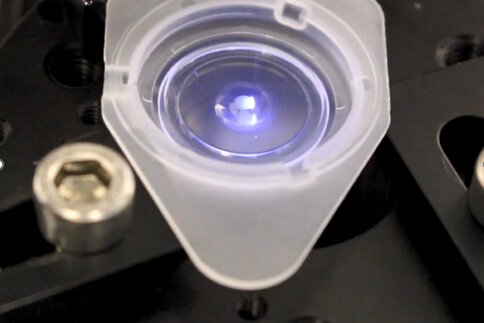Using Photonics 4.0 to create personalized intraocular lenses
Every year, more than 20 million people around the world undergo cataract operations to have their affected lenses replaced with plastic ones. An Aachen-based start-up has developed a Photonics 4.0 process chain for their manufacture.

“Laser material processing is ideal for Industry 4.0,”—that was the title of a 2018 PHOTONICS interview with Prof. Reinhart Poprawe. The now emeritus Head of the Fraunhofer Institute for Laser Technology ILT in Aachen has followed up his words with action. As founder of AIXLens GmbH, in close cooperation with his old institute he is driving the development of a digitally controlled, fully automated photonic process chain that will manufacture personalized intraocular lenses in future.
These lenses, made of biocompatible plastics, are used by more than half a million patients suffering from cataracts a year in Germany alone. Around the world, well over 20 million operations of this nature take place. The lenses are injected into the eye folded up, where they are unfolded and held in place in the capsular bag by two tiny, opposite-facing struts. In most cases, these lenses are injection-molded and mass-produced. However, for patients who already had defective vision, the lenses need to be adapted to the individual. There are several hundred variants provided by specialized practices and clinics. But because they can only be stored for a limited amount of time, they need to be disposed of if an appropriate recipient cannot be found in time. This is where the 4.0 process chain of Poprawe’s start-up comes in. “The great advantage of fully automated, digitalized laser process chains is that the costs are dissociated from how much you manufacture. Therefore we are able to make even very complex, individually adapted lenses on-demand,” he explained. The same goes for additive and subtractive processes. He added that, wherever it is possible to manufacture cost-effectively and within hours from piece number one, it is also possible to do away with warehousing and all the associated follow-up costs.
Laser-based pilot production at the ILT
The intraocular lenses from AIXLens utilize a subtractive process. At the start of the fully automated process chain, an ultra-short pulse laser cuts the shape of the lens together with the struts (technically called “haptics”) out of an injection-molded blank. In order to minimize the thermal impact, the laser traces the outline several dozen times, penetrating a little deeper into the plastic with each pulse. Once the shape is released, the second step in the process is to remove the lens. This is also done by an ultra-short pulse laser, which shapes the lens based on the individually determined patient data. Once personalized, the lens is polished with a continuous wave (CW) laser, which corrects imperfections down to the nanometer. “With laser processing, polymer chains sometimes break, which reduces biocompatibility. We are able to rectify this with a final pass,” said Poprawe. He explained how there are various light- and electron-based approaches for re-crosslinking the polymers, and his team is currently testing and optimizing their efficiency.
AIXLens developed the pilot chain in close cooperation with the ILT. The test runs and quality checks are currently also taking place there. The optical quality of the lenses has already been proven with standardized Modular Transfer Function (MTF) tests. The same goes for their ability to be injected. And proof of biocompatibility with cytotoxicity tests, i.e. with living cells, is also well advanced. If this is also successful, nothing will stand in the way of the CE conformity of the fully automatically manufactured intraocular lenses.
Great interest on the market
Meanwhile, after pitches and presentations at various specialist conferences, the start-up is communicating with the world’s leading manufacturers of these kinds of intraocular lenses. “The prospect of being able to order personalized lenses just-in-time and do away with storage is generating a large amount of interest in our process,” said Poprawe. There will still be a mass market for injection-molded standard lenses, the storage of which is unproblematic due to the continuous demand. But even then, if a less common variant is required, on-demand manufacturing offers a clear advantage. “Even if we cover just one percent of the world’s operations, that would come to more than 200,000 personalized lenses a year,” he estimates.
But it doesn’t have to stay that way. Because the recently founded AIXLens GmbH, together with the Fraunhofer ILT and its 3D printing spin-off Aconity3D, is contributing the surface know-how it has gained to research projects that deal with the surface quality of components and plastic implants made through additive manufacturing. Here, too, the potential of photonic 4.0 process chains is enormous. If plastic components are to be manufactured in additive processes with significantly higher build-up rates, this will result in more porous and therefore rougher surfaces. Here, automated post-processing using particle-free, selective laser polishing can optimize the surfaces exactly where necessary, for example to avoid friction. Many fully automated 4.0 process chains will be created based on this in the future, and their data and processing processes now need to be synchronized. There is no longer any doubt that laser material processing is ideal for Industry 4.0. Now it’s a matter of optimizing the individual processes and linking them to the appropriate interfaces. This work is well under way.
